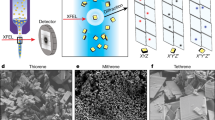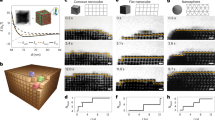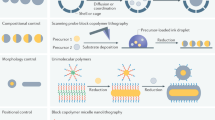Abstract
Thanks to recent technological advances in X-ray and micro-electron diffraction and solid-state NMR, structural information can be obtained by using much smaller crystals. Thus, microcrystals have become a valuable commodity rather than a mere stepping stone toward obtaining macroscopic crystals. Microcrystals are particularly useful for structure determination using serial data collection approaches at synchrotrons and X-ray free-electron lasers. The latter’s enormous peak brilliance and short X-ray pulse duration mean that structural information can be obtained before the effects of radiation damage are seen; these properties also facilitate time-resolved crystallography. To establish defined reaction initiation conditions, microcrystals with a desired and narrow size distribution are critical. Here, we describe milling and seeding techniques as well as filtration approaches for the reproducible and size-adjustable preparation of homogeneous nano- and microcrystals. Nanocrystals and crystal seeds can be obtained by milling using zirconium beads and the BeadBug homogenizer; fragmentation of large crystals yields micro- or nanocrystals by flowing crystals through stainless steel filters by using an HPLC pump. The approaches can be scaled to generate micro- to milliliter quantities of microcrystals, starting from macroscopic crystals. The procedure typically takes 3–5 d, including the time required to grow the microcrystals.
This is a preview of subscription content, access via your institution
Access options
Access Nature and 54 other Nature Portfolio journals
Get Nature+, our best-value online-access subscription
$29.99 / 30 days
cancel any time
Subscribe to this journal
Receive 12 print issues and online access
$259.00 per year
only $21.58 per issue
Buy this article
- Purchase on Springer Link
- Instant access to full article PDF
Prices may be subject to local taxes which are calculated during checkout










Similar content being viewed by others
Data availability
Data and coordinates for the example proteins have been submitted to the Protein Data Bank; the PDB codes are given in Supplementary Table 1 (8A9E, 4N5R, 8A9F, 5FGT; e.g., https://www.rcsb.org/structure/4N5R). Other data are available from the authors upon reasonable request.
References
Chapman, H. N., Caleman, C. & Timneanu, N. Diffraction before destruction. Philos. Trans. R. Soc. Lond. B Biol. Sci. 369, 20130313 (2014).
Grünbein, M. L. et al. Illumination guidelines for ultrafast pump-probe experiments by serial femtosecond crystallography. Nat. Methods 17, 681–684 (2020).
Schmidt, M. Mix and inject: reaction initiation by diffusion for time-resolved macromolecular crystallography. Adv. Condens. Matter Phys. 2013, 167276 (2013).
Weierstall, U., Spence, J. C. & Doak, R. B. Injector for scattering measurements on fully solvated biospecies. Rev. Sci. Instrum. 83, 035108 (2012).
Barends, T. R. et al. Direct observation of ultrafast collective motions in CO myoglobin upon ligand dissociation. Science 350, 445–450 (2015).
Pande, K. et al. Femtosecond structural dynamics drives the trans/cis isomerization in photoactive yellow protein. Science 352, 725–729 (2016).
Coquelle, N. et al. Chromophore twisting in the excited state of a photoswitchable fluorescent protein captured by time-resolved serial femtosecond crystallography. Nat. Chem. 10, 31–37 (2018).
Barends, T. R. M., Stauch, B., Cherezov, V. & Schlichting, I. Serial femtosecond crystallography. Nat. Rev. Methods Primers 2, 59 (2022).
Son, S. K., Chapman, H. N. & Santra, R. Multiwavelength anomalous diffraction at high x-ray intensity. Phys. Rev. Lett. 107, 218102 (2011).
Galli, L. et al. Towards phasing using high X-ray intensity. IUCrJ 2, 627–634 (2015).
Nass, K. et al. Indications of radiation damage in ferredoxin microcrystals using high-intensity X-FEL beams. J. Synchrotron Radiat. 22, 225–238 (2015).
Nass, K. et al. Structural dynamics in proteins induced by and probed with X-ray free-electron laser pulses. Nat. Commun. 11, 1814 (2020).
Subramanian, G., Basu, S., Liu, H., Zuo, J. M. & Spence, J. C. H. Solving protein nanocrystals by cryo-EM diffraction: multiple scattering artifacts. Ultramicroscopy 148, 87–93 (2015).
Liu, W., Ishchenko, A. & Cherezov, V. Preparation of microcrystals in lipidic cubic phase for serial femtosecond crystallography. Nat. Protoc. 9, 2123–2134 (2014).
Roedig, P. et al. A micro-patterned silicon chip as sample holder for macromolecular crystallography experiments with minimal background scattering. Sci. Rep. 5, 10451 (2015).
Oghbaey, S. et al. Fixed target combined with spectral mapping: approaching 100% hit rates for serial crystallography. Acta Crystallogr. D. 72, 944–955 (2016).
Mehrabi, P. et al. The HARE chip for efficient time-resolved serial synchrotron crystallography. J. Synchrotron Radiat. 27, 360–370 (2020).
Weierstall, U. et al. Lipidic cubic phase injector facilitates membrane protein serial femtosecond crystallography. Nat. Commun. 5, 3309 (2014).
Botha, S. et al. Room temperature serial crystallography at synchrotron X-ray sources. Acta Crystallogr. D. 71, 387–397 (2015).
Fromme, P. & Spence, J. C. Femtosecond nanocrystallography using X-ray lasers for membrane protein structure determination. Curr. Opin. Struct. Biol. 21, 509–516 (2011).
Darmanin, C. et al. Protein crystal screening and characterization for serial femtosecond nanocrystallography. Sci. Rep. 6, 25345 (2016).
Beale, J. H. et al. Successful sample preparation for serial crystallography experiments. J. Appl. Crystallogr. 52, 1385–1396 (2019).
Stohrer, C. et al. Homogeneous batch micro-crystallization of proteins from ammonium sulfate. Acta Crystallogr. D. Biol. Crystallogr. 77, 194–204 (2021).
Srinivas, V. et al. High-resolution XFEL structure of the soluble methane monooxygenase hydroxylase complex with its regulatory component at ambient temperature in two oxidation states. J. Am. Chem. Soc. 142, 14249–14266 (2020).
Dods, R. et al. From macrocrystals to microcrystals: a strategy for membrane protein serial crystallography. Structure 25, 1461–1468.e2 (2017).
Schlichting, I. Serial femtosecond crystallography: the first five years. IUCrJ 2, 246–255 (2015).
Martin, R. W. & Zilm, K. W. Preparation of protein nanocrystals and their characterization by solid state NMR. J. Magn. Reson. 165, 162–174 (2003).
Kupitz, C. et al. Microcrystallization techniques for serial femtosecond crystallography using photosystem II from Thermosynechococcus elongatus as a model system. Philos. Trans. R. Soc. Lond. Biol. Sci. 369, 20130316 (2014).
de la Cruz, M. J. et al. Micro- and nanocrystal preparation for MicroED and XFEL serial crystallography by fragmentation of imperfect crystals. Protocol Exchange https://doi.org/10.1038/protex.2017.010 (2017).
Lee, D. B. et al. Supersaturation-controlled microcrystallization and visualization analysis for serial femtosecond crystallography. Sci. Rep. 8, 2541 (2018).
Falkner, J. C. et al. Generation of size-controlled, submicrometer protein crystals. Chem. Mater. 17, 2679–2686 (2005).
Ibrahim, M. et al. Improvements in serial femtosecond crystallography of photosystem II by optimizing crystal uniformity using microseeding procedures. Struct. Dyn. 2, 041705 (2015).
Coe, J. et al. Crystallization of photosystem II for time-resolved structural studies using an X-ray free electron laser. Methods Enzymol. 557, 459–482 (2015).
Murakawa, T. et al. Microcrystal preparation for serial femtosecond X-ray crystallography of bacterial copper amine oxidase. Acta Crystallogr. F. Struct. Biol. Commun. 77, 356–363 (2021).
Kern, J. et al. Simultaneous femtosecond X-ray spectroscopy and diffraction of photosystem II at room temperature. Science 340, 491–495 (2013).
Young, I. D. et al. Structure of photosystem II and substrate binding at room temperature. Nature 540, 453–457 (2016).
Suga, M. et al. Light-induced structural changes and the site of O=O bond formation in PSII caught by XFEL. Nature 543, 131–135 (2017).
Doak, R. B. et al. Crystallography on a chip - without the chip: sheet-on-sheet sandwich. Acta Crystallogr. D. Struct. Biol. 74, 1000–1007 (2018).
Sorigue, D. et al. Mechanism and dynamics of fatty acid photodecarboxylase. Science 372, eabd5687 (2021).
Nass, K. et al. Protein structure determination by single-wavelength anomalous diffraction phasing of X-ray free-electron laser data. IUCrJ 3, 180–191 (2016).
Woodhouse, J. et al. Photoswitching mechanism of a fluorescent protein revealed by time-resolved crystallography and transient absorption spectroscopy. Nat. Commun. 11, 741 (2020).
Zech, S. G., Wand, A. J. & McDermott, A. E. Protein structure determination by high-resolution solid-state NMR spectroscopy: application to microcrystalline ubiquitin. J. Am. Chem. Soc. 127, 8618–8626 (2005).
Shahid, S. A. et al. Membrane-protein structure determination by solid-state NMR spectroscopy of microcrystals. Nat. Methods 9, 1212–1217 (2012).
Gati, C. et al. Serial crystallography on in vivo grown microcrystals using synchrotron radiation. IUCrJ 1, 87–94 (2014).
Stellato, F. et al. Room-temperature macromolecular serial crystallography using synchrotron radiation. IUCrJ 1, 204–212 (2014).
Nogly, P. et al. Lipidic cubic phase serial millisecond crystallography using synchrotron radiation. IUCrJ 2, 168–176 (2015).
Weinert, T. et al. Serial millisecond crystallography for routine room-temperature structure determination at synchrotrons. Nat. Commun. 8, 542 (2017).
Owen, R. L. et al. Low-dose fixed-target serial synchrotron crystallography. Acta Crystallogr. D. Struct. Biol. 73, 373–378 (2017).
Diederichs, K. & Wang, M. Serial synchrotron X-ray crystallography (SSX). Methods Mol. Biol. 1607, 239–272 (2017).
Sierra, R. G. et al. Nanoflow electrospinning serial femtosecond crystallography. Acta Crystallogr. D. Biol. Crystallogr. 68, 1584–1587 (2012).
Sierra, R. G. et al. Concentric-flow electrokinetic injector enables serial crystallography of ribosome and photosystem II. Nat. Methods 13, 59–62 (2016).
Fuller, F. D. et al. Drop-on-demand sample delivery for studying biocatalysts in action at X-ray free-electron lasers. Nat. Methods 14, 443–449 (2017).
Roedig, P. et al. High-speed fixed-target serial virus crystallography. Nat. Methods 14, 805–810 (2017).
Bücker, R. et al. Serial protein crystallography in an electron microscope. Nat. Commun. 11, 996 (2020).
Grünbein, M. L. & Kovacs, G. N. Sample delivery for serial crystallography at free-electron lasers and synchrotrons. Acta Crystallogr. D. Struct. Biol. 75, 178–191 (2019).
Martiel, I., Muller-Werkmeister, H. M. & Cohen, A. E. Strategies for sample delivery for femtosecond crystallography. Acta Crystallogr. D. Biol. Crystallogr. 75, 160–177 (2019).
Weierstall, U. Liquid sample delivery techniques for serial femtosecond crystallography. Philos. Trans. R. Soc. Lond. B Biol. Sci. 369, 20130337 (2014).
Roessler, C. G. et al. Acoustic injectors for drop-on-demand serial femtosecond crystallography. Structure 24, 631–640 (2016).
Baxter, E. L. et al. High-density grids for efficient data collection from multiple crystals. Acta Crystallogr. D. Struct. Biol. 72, 2–11 (2016).
Schlichting, I. & Goody, R. S. Triggering methods in crystallographic enzyme kinetics. Methods Enzymol. 277, 467–490 (1997).
Rodriguez, J. A. et al. Structure of the toxic core of alpha-synuclein from invisible crystals. Nature 525, 486–490 (2015).
de la Cruz, M. J. et al. Atomic-resolution structures from fragmented protein crystals with the cryoEM method MicroED. Nat. Methods 14, 399–402 (2017).
Hattne, J. et al. Analysis of global and site-specific radiation damage in cryo-EM. Structure 26, 759–766.e4 (2018).
Nass, K. Radiation damage in protein crystallography at X-ray free-electron lasers. Acta Crystallogr. D. Struct. Biol. 75, 211–218 (2019).
Grünbein, M. L. et al. Effect of X-ray free-electron laser-induced shockwaves on haemoglobin microcrystals delivered in a liquid jet. Nat. Commun. 12, 1672 (2021).
Luft, J. R. & DeTitta, G. T. A method to produce microseed stock for use in the crystallization of biological macromolecules. Acta Crystallogr. D. Biol. Crystallogr. 55, 988–993 (1999).
Kern, J. et al. Purification, characterisation and crystallisation of photosystem II from Thermosynechococcus elongatus cultivated in a new type of photobioreactor. Biochim. Biophys. Acta 1706, 147–157 (2005).
Benvenuti, M. & Mangani, S. Crystallization of soluble proteins in vapor diffusion for x-ray crystallography. Nat. Protoc. 2, 1633–1651 (2007).
Chayen, N. E. & Saridakis, E. Protein crystallization: from purified protein to diffraction-quality crystal. Nat. Methods 5, 147–153 (2008).
Asherie, N. Protein crystallization and phase diagrams. Methods 34, 266–272 (2004).
Caffrey, M. & Cherezov, V. Crystallizing membrane proteins using lipidic mesophases. Nat. Protoc. 4, 706–731 (2009).
Bergfors, T. Seeds to crystals. J. Struct. Biol. 142, 66–76 (2003).
D’Arcy, A., Villard, F. & Marsh, M. An automated microseed matrix-screening method for protein crystallization. Acta Crystallogr. D. Biol. Crystallogr. 63, 550–554 (2007).
Schlichting, I. & Miao, J. Emerging opportunities in structural biology with X-ray free-electron lasers. Curr. Opin. Struct. Biol. 22, 613–626 (2012).
Tenboer, J. et al. Time-resolved serial crystallography captures high-resolution intermediates of photoactive yellow protein. Science 346, 1242–1246 (2014).
Stevenson, H. P. et al. Transmission electron microscopy for the evaluation and optimization of crystal growth. Acta Crystallogr. D. Biol. Crystallogr. 72, 603–615 (2016).
Rapaport, H. et al. From nucleation to engineering of crystalline architectures at air-liquid interfaces. J. Phys. Chem. B 104, 1399–1428 (2000).
Tian, W. Q., Rielly, C. & Yang, H. Protein crystallisation with air bubble templates: case of gas-liquid-solid interfaces. CrystEngComm 23, 8159–8168 (2021).
Becker, R., Loll, B. & Meinhart, A. Snapshots of the RNA processing factor SCAF8 bound to different phosphorylated forms of the carboxyl-terminal domain of RNA polymerase II. J. Biol. Chem. 283, 22659–22669 (2008).
Koopmann, R. et al. In vivo protein crystallization opens new routes in structural biology. Nat. Methods 9, 259–262 (2012).
Bublitz, M. et al. Structural studies of P-type ATPase-ligand complexes using an X-ray free-electron laser. IUCrJ 2, 409–420 (2015).
DePonte, D. P. et al. Gas dynamic virtual nozzle for generation of microscopic droplet streams. J. Phys. D. Appl. Phys. 41, 195505 (2008).
Grünbein, M. L. et al. Megahertz data collection from protein microcrystals at an X-ray free-electron laser. Nat. Commun. 9, 3487 (2018).
Wiedorn, M. O. et al. Rapid sample delivery for megahertz serial crystallography at X-ray FELs. IUCrJ 5, 574–584 (2018).
Wiedorn, M. O. et al. Megahertz serial crystallography. Nat. Commun. 9, 4025 (2018).
Sugahara, M. et al. Grease matrix as a versatile carrier of proteins for serial crystallography. Nat. Methods 12, 61–63 (2015).
Li, H. et al. Structure- and function-based design of Plasmodium-selective proteasome inhibitors. Nature 530, 233–236 (2016).
Miller, J. R., Helprin, J. J. & Finlayson, J. S. Silicone lubricant flushed from disposable syringes: determination by atomic absorption spectrophotometry. J. Pharm. Sci. 58, 455–456 (1969).
Neutze, R., Wouts, R., van der Spoel, D., Weckert, E. & Hajdu, J. Potential for biomolecular imaging with femtosecond X-ray pulses. Nature 406, 752–757 (2000).
Boutet, S. et al. High-resolution protein structure determination by serial femtosecond crystallography. Science 337, 362–364 (2012).
Hattne, J. et al. Accurate macromolecular structures using minimal measurements from X-ray free-electron lasers. Nat. Methods 11, 545–548 (2014).
Liang, M. N. et al. The Coherent X-ray Imaging instrument at the Linac Coherent Light Source. J. Synchrotron Radiat. 22, 514–519 (2015).
Acknowledgements
We are grateful to T. Barends for making the initial versions of Figs. 1, 2, 7 and 8. We thank M. Kloos for sharing the preliminary data on fracturing LCP-grown bacteriorhodopsin crystals by filtration. We thank the Heidelberg FEL group for discussions and detailed feedback on the protocol during many XFEL beamtimes and the prior preparations. The work was supported by the Max Planck Society.
Author information
Authors and Affiliations
Contributions
R.L.S. and I.S. conceived and established the protocols, and E.H. applied and fine-tuned the protocols for different systems. R.L.S. and I.S. wrote the manuscript with the help of E.H.
Corresponding author
Ethics declarations
Competing interests
The authors declare no competing interests.
Peer review
Peer review information
Nature Protocols thanks the anonymous reviewers for their contribution to the peer review of this work.
Additional information
Publisher’s note Springer Nature remains neutral with regard to jurisdictional claims in published maps and institutional affiliations.
Related links
Key references using this protocol
Barends, T. R. et al. Science 350, 445–450 (2015): https://doi.org/10.1126/science.aac5492
Nass, K. et al. IUCrJ 3, 180–191 (2016): https://doi.org/10.1107/S2052252516002980
Coquelle, N. et al. Nat. Chem. 10, 31–37 (2018): https://doi.org/10.1038/nchem.2853
Nass, K. et al. Nat. Commun. 11, 1814 (2020): https://doi.org/10.1038/s41467-020-15610-4
Sorigue, D. et al. Science 372, eabd5687 (2021): https://doi.org/10.1126/science.abd5687
Supplementary information
Supplementary Information
Supplementary Results 1–3, Methods, Note, Table 1 and Figs. 1–10.
Rights and permissions
Springer Nature or its licensor (e.g. a society or other partner) holds exclusive rights to this article under a publishing agreement with the author(s) or other rightsholder(s); author self-archiving of the accepted manuscript version of this article is solely governed by the terms of such publishing agreement and applicable law.
About this article
Cite this article
Shoeman, R.L., Hartmann, E. & Schlichting, I. Growing and making nano- and microcrystals. Nat Protoc 18, 854–882 (2023). https://doi.org/10.1038/s41596-022-00777-5
Received:
Accepted:
Published:
Issue Date:
DOI: https://doi.org/10.1038/s41596-022-00777-5
This article is cited by
Comments
By submitting a comment you agree to abide by our Terms and Community Guidelines. If you find something abusive or that does not comply with our terms or guidelines please flag it as inappropriate.



